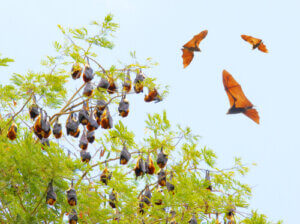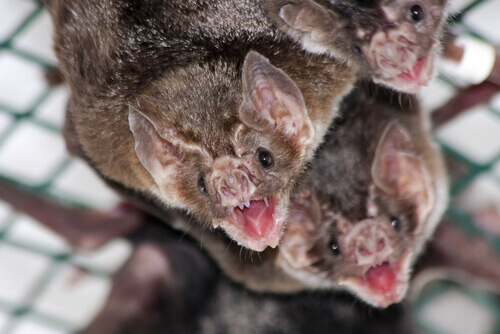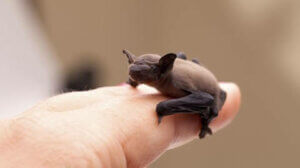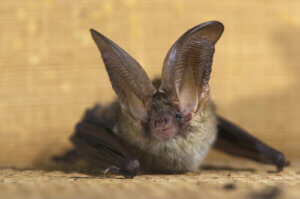5 Bat Species

Bats are the only mammals that can fly. Thanks to this unique characteristic, they’ve been able to settle almost everywhere on the planet. Despite superstitions, almost all of them feed on fruit or insects. We invite you to discover 5 amazing bat species.
Bat species basics
Bats are the second-largest family of the animal kingdom, second only to rodents. Experts estimate that there are about 1,200 different bat species. However, the number is increasing, as new species are discovered every few years.
Bats live almost everywhere on the planet. With the exception of the poles, they’ve spread all over the world. As expected in such a large family, this has induced very different evolution mechanisms: the smallest bats weigh only a few grams, while the largest reach almost 1 kilogram (2.2 lb).
1. Common bat
This is the smallest of the European bat species. They’re only 6 cm (2.4 in) long and have a wingspan of 20 to 25 cm (8 to 10 in) when their wings are fully extended. They’re brownish or grayish in color, sometimes almost black, but the belly has a lighter shade.

They have small ears and a short snout. They feed on small insects such as beetles or mosquitoes. This species hibernates from the end of autumn until the arrival of spring. They live in large groups, both while awake and throughout the winter.
This type of bat lives in urbanized areas throughout the Iberian Peninsula and the Balearic Islands. In fact, they’re the small bats that we can see at dusk on beaches or in villages near forests.
2. Another bat species: the flying fox
The giant golden-crowned flying fox, on the other hand, is one of the largest bat species in existence. It feeds only on fruit and flower nectar, so it has an important pollinating function across its habitat.

It doesn’t use the echolocation system, but guides itself by sight and smell. This is very unlike the majority of the other bat species whose vision barely allows them to distinguish blurred shapes or light from darkness.
As its name indicates, its face resembles that of a fox. It has an elongated and sharp snout, large eyes compared to other animals of its species, and triangular erect ears. Its body is covered with reddish fur.
It lives on some islands in Oceania: the Malay Peninsula, the Philippines, Sumatra, Borneo… It’s not an endangered species, but it’s closely monitored due to the decline of its population.
3. Vampire bat
Vampire bats are a suborder of the species. Of these, only three extant species feed only on blood, despite superstitions. Physically, they differ from fruit-eating bats in that they have short, flat snouts and small ears.

In order to catch their prey, they’re able to see the infrared radiation emitted by bodies that contain blood, and clearly hear the slow breathing of sleeping animals. So they know where arteries are located, which ones are easier to access, and when to approach their prey.
Unlike other bats, they’re nocturnal and only come out when it’s completely dark. Their prey is usually large livestock or birds, and there’s one species that can also feed on humans.
These three species are widespread in the Americas. They only live in certain parts of Mexico, Chile, Argentina and Brazil. The greatest danger they pose to humans is the transmission of parasites or viruses such as rabies, but this happens very rarely.
4. The smallest bat species: Kitti’s hog-nosed bat
As its name suggests, the most distinctive feature of this animal is its pig-like snout. This is where similarities end, as this bat is much smaller than pigs. It barely weighs 2 grams (0.07 oz) and is one of the smallest mammals in existence.

It lives in western Thailand and part of Burma, and inhabits very humid areas such as caves near riverbanks. Unfortunately, this species is endangered.
5. Grey long-eared bat
This is another bat species that lives in the Iberian Peninsula. However, it inhabits wooded areas far away from human settlements, and the treetops.

As its name indicates, its ears are extraordinarily long and, when at rest, are tucked behind its head. The ears are so large that they can be twice the size of its head. Its body is of medium size: between 3 and 6 cm (1.2 to 2.4 in) in length and almost 25 cm (10 in) in wingspan, so its ears are very noticeable.
Bats often appear in horror stories, but nothing could be further from the truth. The vast majority feed on fruit or insects and are harmless to humans. Some have a role in pollination and pest control.
Bats are the only mammals that can fly. Thanks to this unique characteristic, they’ve been able to settle almost everywhere on the planet. Despite superstitions, almost all of them feed on fruit or insects. We invite you to discover 5 amazing bat species.
Bat species basics
Bats are the second-largest family of the animal kingdom, second only to rodents. Experts estimate that there are about 1,200 different bat species. However, the number is increasing, as new species are discovered every few years.
Bats live almost everywhere on the planet. With the exception of the poles, they’ve spread all over the world. As expected in such a large family, this has induced very different evolution mechanisms: the smallest bats weigh only a few grams, while the largest reach almost 1 kilogram (2.2 lb).
1. Common bat
This is the smallest of the European bat species. They’re only 6 cm (2.4 in) long and have a wingspan of 20 to 25 cm (8 to 10 in) when their wings are fully extended. They’re brownish or grayish in color, sometimes almost black, but the belly has a lighter shade.

They have small ears and a short snout. They feed on small insects such as beetles or mosquitoes. This species hibernates from the end of autumn until the arrival of spring. They live in large groups, both while awake and throughout the winter.
This type of bat lives in urbanized areas throughout the Iberian Peninsula and the Balearic Islands. In fact, they’re the small bats that we can see at dusk on beaches or in villages near forests.
2. Another bat species: the flying fox
The giant golden-crowned flying fox, on the other hand, is one of the largest bat species in existence. It feeds only on fruit and flower nectar, so it has an important pollinating function across its habitat.

It doesn’t use the echolocation system, but guides itself by sight and smell. This is very unlike the majority of the other bat species whose vision barely allows them to distinguish blurred shapes or light from darkness.
As its name indicates, its face resembles that of a fox. It has an elongated and sharp snout, large eyes compared to other animals of its species, and triangular erect ears. Its body is covered with reddish fur.
It lives on some islands in Oceania: the Malay Peninsula, the Philippines, Sumatra, Borneo… It’s not an endangered species, but it’s closely monitored due to the decline of its population.
3. Vampire bat
Vampire bats are a suborder of the species. Of these, only three extant species feed only on blood, despite superstitions. Physically, they differ from fruit-eating bats in that they have short, flat snouts and small ears.

In order to catch their prey, they’re able to see the infrared radiation emitted by bodies that contain blood, and clearly hear the slow breathing of sleeping animals. So they know where arteries are located, which ones are easier to access, and when to approach their prey.
Unlike other bats, they’re nocturnal and only come out when it’s completely dark. Their prey is usually large livestock or birds, and there’s one species that can also feed on humans.
These three species are widespread in the Americas. They only live in certain parts of Mexico, Chile, Argentina and Brazil. The greatest danger they pose to humans is the transmission of parasites or viruses such as rabies, but this happens very rarely.
4. The smallest bat species: Kitti’s hog-nosed bat
As its name suggests, the most distinctive feature of this animal is its pig-like snout. This is where similarities end, as this bat is much smaller than pigs. It barely weighs 2 grams (0.07 oz) and is one of the smallest mammals in existence.

It lives in western Thailand and part of Burma, and inhabits very humid areas such as caves near riverbanks. Unfortunately, this species is endangered.
5. Grey long-eared bat
This is another bat species that lives in the Iberian Peninsula. However, it inhabits wooded areas far away from human settlements, and the treetops.

As its name indicates, its ears are extraordinarily long and, when at rest, are tucked behind its head. The ears are so large that they can be twice the size of its head. Its body is of medium size: between 3 and 6 cm (1.2 to 2.4 in) in length and almost 25 cm (10 in) in wingspan, so its ears are very noticeable.
Bats often appear in horror stories, but nothing could be further from the truth. The vast majority feed on fruit or insects and are harmless to humans. Some have a role in pollination and pest control.
This text is provided for informational purposes only and does not replace consultation with a professional. If in doubt, consult your specialist.








